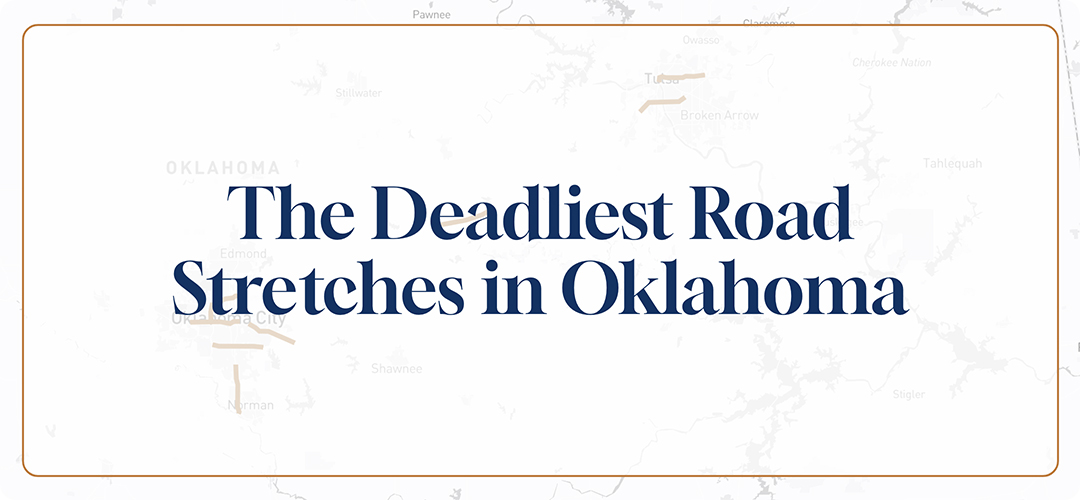Key Takeaways About the Deadliest Road Stretches in Oklahoma Study
- The deadliest stretch in Oklahoma is a 10-mile section of I-40 in Oklahoma City (South Council Road → North MLK Avenue), with 26 fatal crashes and 27 deaths over five years.
- Of the eight deadliest road segments statewide: four are in Oklahoma City, two in Tulsa, one in Norman, and one in Stroud.
- In Tulsa, a stretch of I-244 (Broken Arrow Expressway → North Garnett Road) recorded 19 fatal crashes and 22 deaths, making it the state’s second-most dangerous segment.
While Oklahoma is considered a rural state, nearly 60 percent of the population resides in the metropolitan statistical areas of Oklahoma City and Tulsa. These population centers, along with the highways that connect them, experience high volumes of traffic on a daily basis. From routine commuting to long-haul travel, Oklahoma’s interstate system plays a vital role in how people and goods move through the state. Unfortunately, some of these roadways also see a disproportionate number of fatal vehicle crashes.
To determine which roadways see the most fatal crashes, we created a ranking of Oklahoma’s deadliest 10-mile stretches. We mapped fatal crash points from the National Highway Traffic Safety Administration (NHTSA) for the years 2019 to 2023. Using a rolling window approach, we highlighted the segments with the highest concentration of deadly crashes and continued the process across the state.
Read on to see which stretches ranked as the most fatal.
Interactive Map of Oklahoma’s Deadly Road Stretches
Use the interactive map below to view the 10-mile segments identified in our analysis. You can zoom in to see detailed routes or select from the menu to explore specific metro areas.
Oklahoma’s Metro Areas Home to Deadliest Road Stretches
Below is our ranking for the road stretches in Louisiana with the highest number of fatal crashes between 2019 and 2023. The table shows each stretch, it’s fatal crash and fatality count, along with the nearest city where the segment is located, and the county it resides in. For more details on approximate start and end points, a written overview of each stretch by the nearest city follows below.
Deadly Road Stretches in Oklahoma City
Oklahoma City is home to four of the eight most dangerous highway segments in the state. The deadliest is a 10-mile section of I-40, a major east-west highway and one of the most heavily traveled routes in Oklahoma. This segment stretches from South Council Road to North Martin Luther King Avenue and runs through the heart of the city. Along the way, it provides access to downtown, the state capitol, and key interchanges with I-44 and I-35. It recorded 26 fatal crashes and 27 deaths, more than any other segment in the state.
Another high-risk stretch in the city is on I-44, beginning at I-40 and ending near North Martin Luther King Avenue. This 10-mile segment runs through urban areas of Oklahoma City and saw 19 fatal crashes and 19 deaths. Notable landmarks along this route include the Oklahoma State Fair Park.
On the south side of the city, a segment of I-240 between I-44 and South Midwest Boulevard recorded 13 fatal crashes and 14 deaths. This stretch serves commuters headed to Tinker Air Force Base and the surrounding residential and industrial areas.
A second segment of I-40 also made the list, running from South Sunnylane Road to I-240. It recorded 13 fatal crashes and 13 deaths, ranking seventh overall.
Deadly Road Stretches in Tulsa
Tulsa appears twice in the top rankings, with I-244 and I-44 accounting for two of the most deadly road segments in Oklahoma. The deadlier of the two is a 10-mile stretch of I-244 that runs between the Broken Arrow Expressway and North Garnett Road, with 19 fatal crashes and 22 deaths. This corridor begins near downtown Tulsa and runs northeast, providing access to the Greenwood District, the University of Tulsa, and residential areas. It also connects drivers to Tulsa International Airport.
The second Tulsa segment is located along I-44 between East 41st Street South and West 71st Street South. With 15 fatal crashes over five years, this part of I-44 travels through midtown and south Tulsa.
Fatal Stretches in Norman and Stroud
Just south of Oklahoma City, Norman’s 10-mile stretch of I-35 between State Highway 9 and West Main Street recorded 17 fatal crashes and 17 deaths. This corridor connects the University of Oklahoma and Norman’s downtown with the Oklahoma City metro area, and frequently experiences heavy commuter traffic.
Stroud, a smaller city located along the I-44 corridor between Oklahoma City and Tulsa, also made the list. A 10-mile stretch of I-44 from N3503 Road to N360 Road saw 11 fatal crashes and 12 deaths. This rural segment passes through Lincoln County and includes portions of the Turner Turnpike, a major route connecting the state’s two largest cities.
Methodology
This study uses crash data from 2019 to 2023 provided by the Fatality Analysis Reporting System (FARS), a dataset maintained by the National Highway Traffic Safety Administration (NHTSA).
Fatal crashes were mapped across Oklahoma’s road network and analyzed in 10-mile segments to identify those with the highest concentrations of deadly crashes. The process was repeated to determine subsequent segments with similarly high crash counts. In the event of a tie, the total number of fatalities served as a tiebreaker.
Fair Use Statement
Feel free to cite or share this analysis. We just ask that you please include a link back to the original report to ensure others can review the complete dataset and methodology.

